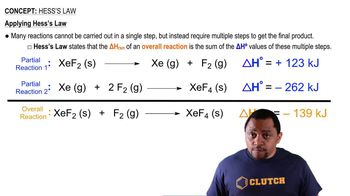Hydrogen and methanol have both been proposed as alternatives to hydrocarbon fuels. Which fuel contains the most energy in the least mass?
Ch.7 - Thermochemistry
Chapter 7, Problem 114
Under certain nonstandard conditions, oxidation by O2(g) of 1 mol of SO2(g) to SO3(g) absorbs 89.5 kJ. The enthalpy of formation of SO3(g) is –204.2 kJ under these conditions. Find the enthalpy of formation of SO2(g).
 Verified step by step guidance
Verified step by step guidance1
Identify the given information: the enthalpy change for the reaction \( \text{SO}_2(g) + \frac{1}{2} \text{O}_2(g) \rightarrow \text{SO}_3(g) \) is +89.5 kJ, and the enthalpy of formation of \( \text{SO}_3(g) \) is -204.2 kJ.
Recall that the enthalpy change for a reaction (\( \Delta H_{\text{rxn}} \)) can be calculated using the enthalpies of formation: \( \Delta H_{\text{rxn}} = \Delta H_f(\text{products}) - \Delta H_f(\text{reactants}) \).
Set up the equation for the enthalpy change of the reaction: \( \Delta H_{\text{rxn}} = \Delta H_f(\text{SO}_3(g)) - \left( \Delta H_f(\text{SO}_2(g)) + \frac{1}{2} \Delta H_f(\text{O}_2(g)) \right) \).
Since the enthalpy of formation of \( \text{O}_2(g) \) is 0 (as it is in its standard state), simplify the equation to: \( 89.5 = -204.2 - \Delta H_f(\text{SO}_2(g)) \).
Solve for \( \Delta H_f(\text{SO}_2(g)) \) by rearranging the equation: \( \Delta H_f(\text{SO}_2(g)) = -204.2 - 89.5 \).

Verified video answer for a similar problem:
This video solution was recommended by our tutors as helpful for the problem above.
Was this helpful?
Key Concepts
Here are the essential concepts you must grasp in order to answer the question correctly.
Enthalpy of Formation
The enthalpy of formation is the change in enthalpy when one mole of a compound is formed from its elements in their standard states. It is a crucial concept in thermodynamics, allowing chemists to understand the energy changes associated with chemical reactions. For example, the enthalpy of formation of SO3 indicates how much energy is released or absorbed when SO3 is formed from sulfur and oxygen.
Recommended video:
Guided course

Enthalpy of Formation
Oxidation-Reduction Reactions
Oxidation-reduction (redox) reactions involve the transfer of electrons between substances, leading to changes in oxidation states. In the given question, the oxidation of SO2 to SO3 involves the loss of electrons by sulfur, which is oxidized. Understanding redox reactions is essential for analyzing energy changes and determining the enthalpy associated with these processes.
Recommended video:
Guided course

Oxidation and Reduction Reactions
Hess's Law
Hess's Law states that the total enthalpy change for a reaction is the sum of the enthalpy changes for individual steps, regardless of the pathway taken. This principle allows for the calculation of unknown enthalpy changes by using known values. In this case, Hess's Law can be applied to relate the enthalpy of formation of SO2 to the enthalpy changes associated with the oxidation of SO2 to SO3.
Recommended video:
Guided course

Hess's Law
Related Practice
Textbook Question
Textbook Question
Hydrogen and methanol have both been proposed as alternatives to hydrocarbon fuels. How does the energy of these fuels compare to that of octane (C8H18)?
Textbook Question
A mixture of 2.0 mol of H2(g) and 1.0 mol of O2(g) is placed in a sealed evacuated container made of a perfect insulating material at 25 °C. The mixture is ignited with a spark and reacts to form liquid water. Determine the temperature of the water.
Textbook Question
A 20.0-L volume of an ideal gas in a cylinder with a piston is at a pressure of 3.0 atm. Enough weight is suddenly removed from the piston to lower the external pressure to 1.5 atm. The gas then expands at constant temperature until its pressure is 1.5 atm. Find w.
17
views
